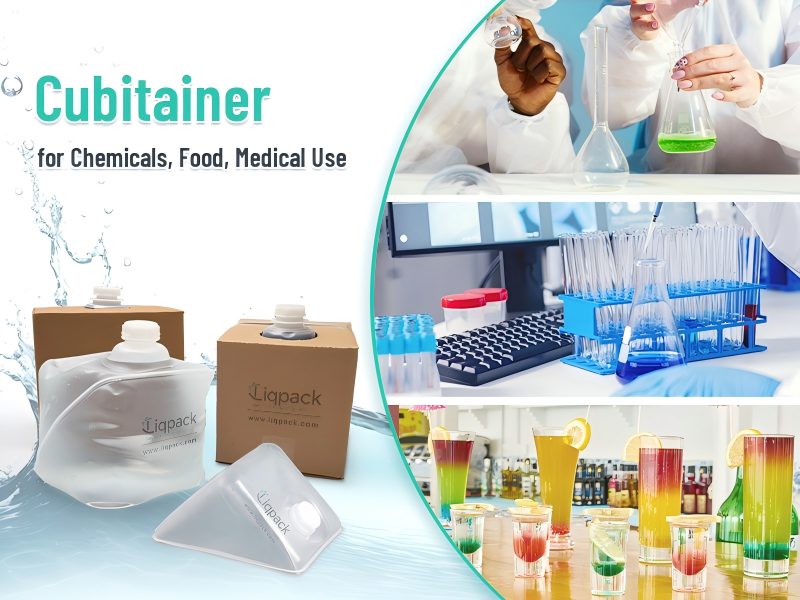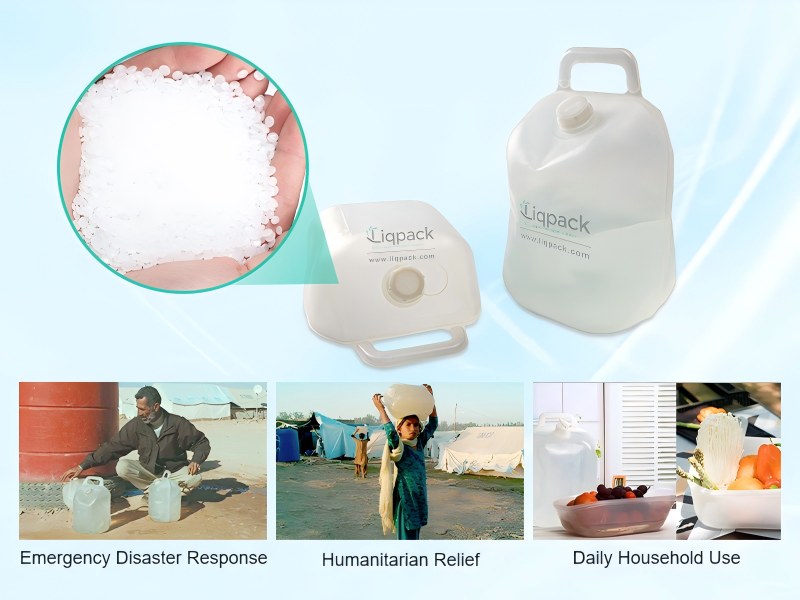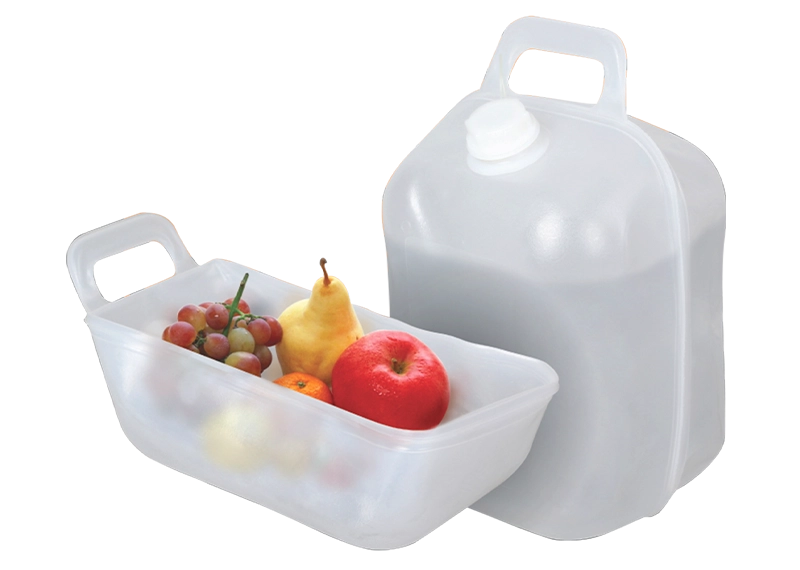
LDPE balances toughness and flexibility, resisting cracks from impacts and handling repeated expansion/contraction without losing shape. Unlike rigid HDPE cans, semi-collapsible LDPE compresses slightly as volume drops, reducing slosh and air exposure while still standing upright and stacking reliably. For adventurers, this means quieter transport, easier packing, and fewer leaks during altitude changes.
Thermal Behavior:
LDPE handles typical outdoor conditions (- −40 °C to ~60 °C) without becoming brittle or floppy. Avoid scalding liquids or concentrated heat, since LDPE softens at high temperatures. In the cold, it stays pliable compared to stiffer plastics, helping prevent cracks from bumps.
Chemical Compatibility:
LDPE is safe for potable water and many non-corrosive liquids. For fuel or harsh solvents, use purpose-built containers—this guide focuses on water, gray water, and mild cleaning solutions.
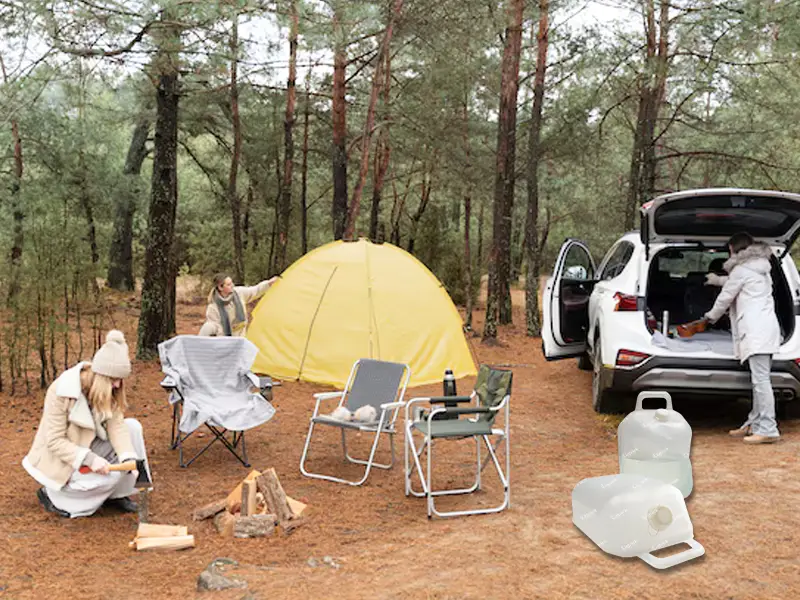
What “Semi-Collapsible” Really Means in the Wild
Semi-collapsible LDPE jerry cans are not soft bladders, and they aren’t rigid bricks. They typically feature:
- Flexible LDPE walls with reinforcing ribs and a stable base so they won’t flop when partially filled.
- Form-retaining geometry—a can that compresses modestly as headspace increases, reducing slosh and pressure spikes.
- Stackable shoulders and grab handles that keep transport safe even when loaded inside vehicles or strapped to roof racks.
- Wide-mouth closures plus tap/spigot options so you can fill, clean, and dispense efficiently.
This middle-ground behavior is invaluable on expeditions across altitude and temperature swings—where rigid cans can balloon and soft bladders can be puncture-prone or awkward to carry.
The Best LDPE Semi-Collapsible Jerry Cans by Use Case
Below are “best-fit” categories instead of brand-by-brand picks (use this as a decision map). All options assume high-quality food-grade LDPE, with UV-stabilized formulations preferred for sun-heavy itineraries.
Best for Weekend Camping (Car-Side Basecamp)
Capacity: 10–15 L
Why: Manageable weight for one person; light enough to carry from the vehicle to the camp kitchen, heavy enough to avoid tipping.
Must-have features:
- Integrated spigot or quarter-turn tap for single-handed dispensing.
- Wide-mouth (≥45 mm) cap for easy fill and chlorination dosing.
- Front and top handles for controlled pour angles.
- Sight strip or translucent body to gauge remaining water.
Best for Overlanding & Remote Vehicle Expeditions
Capacity: 15–20 L (multiple cans preferred)
Why: Modular redundancy beats one huge container. If one can leak, you don’t lose your entire supply.
Must-have features:
- Baffled interior or ribbing to reduce slosh on corrugations.
- Tie-down recesses or molded lugs compatible with straps.
- Replaceable gasket & common cap thread (spares are a lifesaver).
- UV-stabilized LDPE for roof-rack exposure.
Best for Alpine & Cold-Weather Trips
Capacity: 10–12 L
Why: Easier to handle with gloves; smaller volumes reduce freeze-expansion risk.
Must-have features:
- Generous headspace (don’t fill to the brim) to accommodate expansion.
- Flexible LDPE walls that won’t crack as temps drop.
- Glove-friendly cap knurling and a recessed tap that won’t snag.
Best for Desert & High-Heat Environments
Capacity: 15–20 L (stored in shade or covered)
Why: Higher water needs; plan modularly to limit heat soak per can.
Must-have features:
- Thicker wall LDPE and UV inhibitors to slow sun aging.
- Pressure-relief capable cap or semi-collapsible geometry to mitigate swelling.
- Light-color or reflective sleeve to reduce solar gain.
Best for Trek-Supported Basecamps (Porters/Boat Drop)
Capacity: 20 L primary + 5 L scout can
Why: Bulk supply at base with a small day-use can for hikes.
Must-have features:
- Nestable form factor for transit.
- Replaceable spigot seating and spare O-rings.
- Graduations for rationing and cooking measurements.
Quick Comparison Table (What to Prioritize)
| Use Case | Capacity (L) | Carry & Tie-Down | Dispensing | Climate Protection | Notes |
| Weekend Camping | 10–15 | Dual handles; simple straps | Built-in tap | Basic UV stabilization | Easy to clean; great for families |
| Overlanding | 15–20 (×2–3) | Molded lugs; robust tie-downs | Tap + wide-mouth cap | UV-stabilized LDPE | Modular redundancy; field-serviceable parts |
| Alpine/Cold | 10–12 | Glove-friendly grip | Wide cap; optional tap | Flexible in cold; leave headspace | Prevent freeze cracking; avoid brimming |
| Desert/Heat | 15–20 | Roof-rack capable; padded straps | Tap with the dust cap | Thick wall, UV-stabilized | Shade and reflective covers are recommended |
| Trek Basecamp | 20 + 5 | Nestable; porter-friendly | Spigot on 20 L; simple cap on 5 L | Standard UV | Ration markings; day-trip convenience |
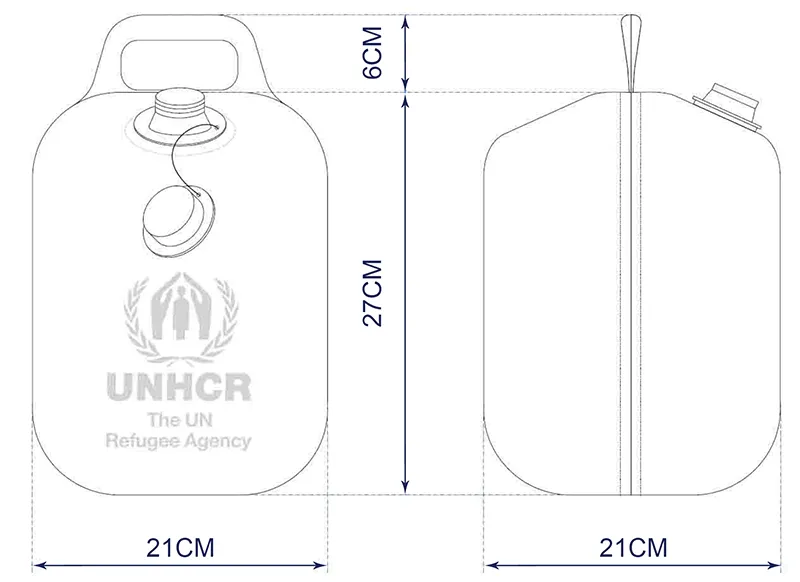
Design Details That Separate Great from Good
Wall Thickness & Ribbing
Look for uniform wall thickness and ribs that resist buckling when partially filled. Ribs should add stiffness without creating dirt traps that complicate cleaning.
Caps, Threads, and Gaskets
Choose caps with deep knurling, replaceable food-grade gaskets, and common thread standards. This is key for field repairs and cross-compatibility with accessories like taps and filters.
Spigot Interface
A robust, serviceable spigot that can be removed for cleaning is a major hygiene and reliability boost. Ensure the seating surface in LDPE is reinforced or well-molded to minimize drip after prolonged use.
Base Stability
A wide, flat base prevents tip-overs on uneven ground. Micro-texture helps the can “grip” surfaces in damp or dusty conditions.
Translucency & Graduations
Slightly translucent LDPE lets you estimate volume; molded graduations or a sight strip make rationing simple. Avoid inks that can wear off—molded marks last longer.
UV Stabilization
For multi-day sun exposure, prioritize UV-stabilized LDPE. Sunlight degrades polymers over time; UV inhibitors slow chalking, embrittlement, and color change.
Hygiene-Forward Geometry
Avoid deep crevices near the neck or base. Wide-mouth openings and smooth interior corners make scrubbing and drying faster, which directly improves taste and safety.
Climate-Specific Tips for LDPE Semi-Collapsible Cans
Cold (High Latitude or Altitude)
- Leave headspace. Water expands when freezing; never fill to the brim.
- Insulate with a wrap or towel and store out of wind to slow freezing.
- Avoid shock loads (e.g., sudden drops) when contents are partially frozen—ice can stress walls.
Heat (Desert/Low Latitude)
- Store shaded and off hot metal surfaces.
- Vent carefully: if the can swells, crack the cap briefly when cool to equalize pressure.
- Use light-colored or reflective covers to cut heat soak.
Big Diurnal Swings (Mountain & Plateau)
- Semi-collapsible geometry shines here—it helps accommodate pressure changes from temperature and altitude.
- Check cap tightness daily; vibrations + pressure pulses can creep threads loose.
Water Quality & Food Safety Notes
When sourcing an LDPE can for drinking water, look for food-grade statements from the manufacturer and choose neutral, low-odor LDPE. Avoid residues: rinse thoroughly after purchase, and periodically sanitize with approved concentrations (e.g., household bleach solutions prepared correctly for potable water systems). Always verify the sanitizer ratio for your can volume and local guidance.
Configuration, Use, and Field Upkeep
Initial Prep
- Rinse with warm water and mild detergent; air dry.
- Sanitize before first use; then rinse if your protocol requires.
- Lubricate the cap gasket lightly with food-safe silicone if recommended—improves sealing and extends gasket life.
Daily Use Habits
- Keep threads and tap clean; dust caps for spigots are worth it.
- Dispense without back-contamination: don’t touch the spout to cookware; pour into an intermediate vessel if needed.
- Rotate stock: on long trips, use older water first.
Cleaning in the Field
- Add warm water + mild detergent, shake vigorously, and use a soft bottle brush for corners.
- For biofilm control, periodically sanitize; let stand per instructions, then drain fully.
- Dry thoroughly before storage—LDPE’s slight flexibility makes it easy to invert and prop open to air out.
Quick Repairs
- Carry spare gaskets/O-rings, a backup cap, and (if used) a spigot kit.
- Micro-scuffs are normal; replace if you see deep gouges or neck/thread deformities that compromise sealing.
Smart Capacity Planning for Adventures
- Solo weekend: 10–12 L suffices for drinking + cooking if you’re conservative and near refill points.
- Two-person, 3–4 days: 15–20 L total, possibly split across two smaller cans for load sharing.
- Remote overlanding (2–4 people): 40–60 L spread across multiple 15–20 L cans; this gives redundancy and easier handling.
- Alpine winter: Plan extra for melting snow (fuel + time overhead) and hot drinks; smaller cans reduce freeze risk and are easier to stash in insulated spaces.
Accessories That Add Real Value
- Tap/spigot with dust cap: Hygienic dispensing at camp.
- Inline filter adapter: If you’ll be topping up from questionable sources, pair your can with a compatible gravity or pump filter (follow the filter’s instructions).
- Tie-down kit: Webbing straps with rubber pads protect LDPE from abrasion and hot metal edges.
- Insulation sleeve or reflective cover: Helpful in deserts and at high altitudes.
- Funnel with sediment screen: Keeps insects and silt out during refills.
For outdoor adventure, camping, and multi-climate expeditions, semi-collapsible LDPE jerry cans deliver the best blend of durability, packability, and reliability. Choose capacities and features based on your mission: smaller, glove-friendly cans for alpine cold; UV-stabilized, thicker-wall models for desert heat; and modular sets of 15–20 L for vehicle-based overlanding. Prioritize wide-mouth access, serviceable spigots, replaceable gaskets, and UV-stabilized LDPE, and carry a minimal spare-parts kit. Do that, and your water supply will be as dependable as the sunrise—trip after trip.
- Liqpack

